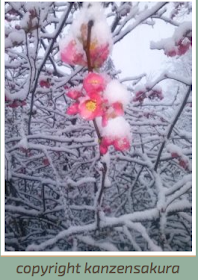Ice Blossoms
The mysterious & beautiful snow flowers of Asia are like
flora from a fantasy. Unlike most plants, the quince blossoms
are resistant to cold, & can survive temperatures plunging
below freezing, can push themselves out of leafless branches
like pink fairies wearing snow bonnets. There are stories about
people who ate too much of the quince fruit, & nearly died
as the seeds converted to cyanide gas.
My friend, a master gardener, claims that most quince trees
blossom in the spring, but that they can blossom up to mid-
winter, illustrating their hardy & unique nature. He said that
these ancient trees, that bear a golden yellow fruit that looks
like a pear, were cultivated even before pear & apple orchards.
He claimed the fruit is ripest in late autumn. Eaten raw, it is
pithy & very tart, leaving a bitter taste in the mouth. Cooked,
the flesh turns red, & can be used in jams, or to enhance other
fruits, much like rhubarb. They are not happy growing in North
America, so show up mostly as ornamental plants.
When we cultivate
plants from antiquity, we
will find uniqueness.
Glenn Buttkus
Posted over on dVerse Poets Pub

This is actually my first time to read and be amazed at such a bloom during winter ~ A delight to the eye for sure like a fantasy plant ~
ReplyDeleteMy father used to crave quince jam when he got old and ill. His mother made it when he was a boy but none of us knew how to do. They are a strange looking fruit and although there are old trees on some old properties here in Australia the fruit is usually left to rot these days. Your haibun makes me think we should learn more about this bountiful tree. Suzanne of Art and Life
ReplyDeleteNice lesson on the quince. I learned something new. Peace, Linda
ReplyDeleteYou are an actor, but also an educator, Glenn. I learn so much from you when you write history or, in this case, science.
ReplyDeleteExcellent haibun. The haiku at the end is stellar. This is the last fruit of the season I use to make jelly from. And it is truly mouth-puckering tart. More so than even unripe persimmons. This bush was rooted for me by mother whose grandmother rooted for her, etc. etc. It is now a monster of a bush and gives shelter from cold and the hot sun to birds and small creatures. I am able to usually put up about 12 pints of jelly from it in the fall. And in snow, it is like a fantasy plant, almost looking like a silk flower with its intense color.
ReplyDeleteAh, thanks for the information about quince, Glenn. I really am not familiar with them at all. I like the haiku...words to reflect on!
ReplyDeleteYou are an educator, Glenn, and I enjoy your lessons. Now I know why I've never seen one, they don't grow here.
ReplyDeleteGlad you posted a second haibun :) Interesting facts about quince...which is also what the Owl and Pussycat dined on!
ReplyDeleteFlower colors
ReplyDeleteflower food..
WinTer BrinGs
tastes SonGs
Red bud
June.. pInk oF
WinTer sNow..:)
I had plenty of quince back in my home country when growing up and have been disappointed to not find it much in other countries. They do have it in France though, so I always treat myself to a few baked in the oven, or else buy some quince jelly (my favourite). Thank you for redoing your haibun to fit the prompt - I really like your final haiku, emphasising the ancient fruit.
ReplyDeleteWe had a quince tree in a previous garden, but I never saw it covered in snow.
ReplyDeleteI had to look for the Swedish name of quince, and then I recognized it... I would love to have it, but apparently Sweden is a little bit too cold for it. We had the related Chaenomeles in our garden... and that also made perfect jelly... Love your prose here... so happy to see you write for it...
ReplyDeleteWonderful haibun Glenn, very informative! The haiku tops it off as the icing, as one can still appreciate an 'antiquity' kind of plant specie.
ReplyDeleteHank
Great haibun! I absolutely love the image of pink fairies wearing snow bonnets
ReplyDeleteYour haibun made me want to try the fruit of the Quince!
ReplyDeleteQuince is well known in South Africa and is used in stews as well. As children we used to play 'kleilat' - an Afrikaans word, by sticking a ball of clay or mud onto the tip and flicking this at each other. Some serious bruising occurred at times. Lovely haibun.
ReplyDeleteThat was informative and yet a joy to read. Nice!
ReplyDelete"...can push themselves out of leafless branches like pink fairies wearing snow bonnets." Love this lovely imagery and magical words in the midst of the more formal descriptions. I learned quite a bit here -- and enjoyed the read too!
ReplyDeleteI enjoyed this informative post very much .. I'd heard of the quince but I don't think that I'v actually seen one though looking at a photo of their fruit just a mo' ago I'd certainly have mistaken them for pears. An you closure haiku was right on! Bastet
ReplyDeleteI love your use of language, so even a factual dissertation is also poetic.
ReplyDeleteI miss the quinces of my childhood! We never see them here any more.